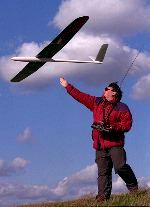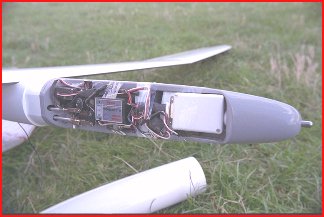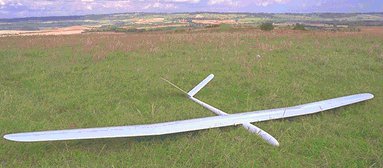Jaro Muller Ellipse - A Development History
 You will lust after an Ellipse when you see one for the first time. The only thing that will hold you back will be the price tag - just over 700 UKP ($1100) at today's prices, plus six quality servos - and a nice new computer radio if you don't already have one!
You will lust after an Ellipse when you see one for the first time. The only thing that will hold you back will be the price tag - just over 700 UKP ($1100) at today's prices, plus six quality servos - and a nice new computer radio if you don't already have one!
The man responsible for this all moulded work of art is Jaroslav M�ller of Piestany in Slovakia.
 My first encounter with the Ellipse was one of the earlier versions now called the Ellipse 1. You had to make the cut-outs for the rudder and elevator servos in the vertical keel, hinge the ailerons and flaps with Sylglas tape, install the wing servos and push rods and that was it.
My first encounter with the Ellipse was one of the earlier versions now called the Ellipse 1. You had to make the cut-outs for the rudder and elevator servos in the vertical keel, hinge the ailerons and flaps with Sylglas tape, install the wing servos and push rods and that was it.
The T-tail was all moving operating on a neat aluminium rocker device. What you ended up with was a model that out-performed everything on the slope and was pretty good for F3B and F3F as well.
Under the Skin
But how is this achieved? Simply, it is the composite construction. As you can see from my diagram of the Ellipse 1 hollow-wing, the wing is a sandwich construction.

The skins are formed of 1mm balsa with 70gsm* glass on either side at 45� bias, with the top surface having an additional ply of 40gsm cloth at 90� bias. This skin gives the wing its very good torsional rigidity - essential for high speed flight. (The all moving stab is constructed in the same way using only 40gsm cloth.)
For spanwise strength there are two spars of carbon fibre tows with a shear web made of blue extruded PS foam wrapped with 200gsm 45� bias glass cloth. The tip panel joiners are carbon fibre as well (~10 x 10mm).
In the Ellipse 1 the ailerons are made of Rohacell 51 (PMI foam) skinned with glass in a separate mould. The whole wing is made in highly accurate moulds which are first sprayed with two pack car paint to give the exceptional surface finish. Interestingly the wing and stab planforms are elliptical even though it appears to have straight leading and trailing edges.
Ellipse Two
After his success with the Ellipse 1, along came Jaro with the Ellipse 2 with an elevator servo at the base of the T-tail fin directly operating the now fixed tailplane with moving elevator. For one reason and another this was not popular so he switched to the standard set up with rudder and elevator servos in the re-designed, remoulded Ellipse 2 fuselage.
 Several other design changes were made as well, the wing section, the ubiquitous RG15, was slightly thinned and the wing was now available in glass or with lightweight carbon fibre (90/100gsm, I guess) replacing the 40+70gsm glass. The wing on the Ellipse 2 comes ready hinged now with a strip of mylar laid up under the skin during manufacture. The aileron and flaps have excellent knuckle hinges that have to be seen to be believed. Jaro also added some nice detail touches too like the ready threaded holes for his supplied control horns.
Several other design changes were made as well, the wing section, the ubiquitous RG15, was slightly thinned and the wing was now available in glass or with lightweight carbon fibre (90/100gsm, I guess) replacing the 40+70gsm glass. The wing on the Ellipse 2 comes ready hinged now with a strip of mylar laid up under the skin during manufacture. The aileron and flaps have excellent knuckle hinges that have to be seen to be believed. Jaro also added some nice detail touches too like the ready threaded holes for his supplied control horns.
V-tail

Then came the fashion for V-tails and Mr. M�ller responded straight away with the Ellipse 2 with V-tail fuselage. Like the other Ellipses, this also uses thick walled aluminium pushrods but this time with ball joints connecting on the extrememly light (60gm) one piece V-tail. And this V-tail model with carbon wings is model to compare all others with at the moment. State of the art, you might say!
There are competitors of course, the most notable being the V-Ultra from Germany, the Fletcher from Holland and the Tragi from Estonia amongst others. Our own UK version of the moulded F3B model is Calypso by Stuart Blanchard.
